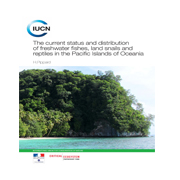The current status and distribution of freshwater fishes, land snails and reptiles in the Pacific Islands of Oceania
This report summarizes the conservation status of 167 freshwater fishes, 166 land snails and 157 reptiles native to the Pacific Islands of Oceania (Micronesia, Polynesia and Melanesia). It identifies Pacific Island species that are threatened with extinction at the global level, according to the IUCN Red List Categories and Criteria

Photo: IUCN
Resources in the Pacific Islands are vulnerable to over-harvesting, deforestation, coastal development and agricultural expansion, with habitat degradation and invasive alien species presenting serious threats to many species. This in turn affects Pacific Islanders who rely on these species for their livelihoods. Therefore, effective conservation measures are needed to safeguard ecosystems and the species they contain. The lack of basic data on species, out-of-date information, and poorly studied areas means that often little is known about species in the region making it difficult to implement conservation plans. In order to conserve the species that are so vital for the health, culture and livelihoods of Pacific Islanders, our knowledge of these species must be improved.
This report summarizes the conservation status of 167 freshwater fishes, 166 land snails and 157 reptiles native to the Pacific Islands of Oceania (Micronesia, Polynesia and Melanesia). It identifies Pacific Island species that are threatened with extinction at the global level, according to the IUCN Red List Categories and Criteria – the world’s most widely accepted methodology for measuring extinction risk. The status of species is based on evaluations made by a regional network of experts, who were trained to carry out biodiversity assessments according to the IUCN Red List Categories and Criteria. Complete assessments are freely available on the IUCN Red List website. Major threats are identified for each taxonomic group, and recommendations for conservation action are suggested.



